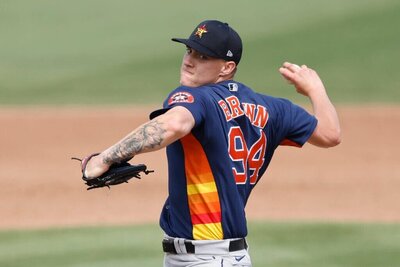Jose Valverde RP (DET) – Valverde earned his 19th save of the season yesterday against the twins, and he now has a brilliant .92 ERA after pitching a 1-2-3 9th inning that included 2 K’s. If you can get value for Valverde as an elite closer, I would do it. There’s a big discrepancy between his ERA and xFIP (3.02) and FIP (3.58). His HR/FB% of 4% is 6 percentage points lower than his career mark. Valverde’s LOB% is nearly 9 percentage points higher than his career mark, and his BABIP of .170 is ridiculously low (career mark of .279). On top of the fact that Valverde is due for some regression due to the incredible luck he has experienced, his K/9 have fallen for the fourth consecutive season while his BB/9 have risen for the second consecutive season. This is not to say Valverde has no value going forward; he has a secure a job as anyone, just won’t be nearly as dominant over the second half. The reason why I don’t expect a complete Valverde blow-up, as the preceding evidence might indicate, is his newfound ability to get groundballs. After spending his career as a FB pitcher, Valverde has discovered a split-finger fastball. After a rough ’06 season (5.84 ERA), Valverde starting throwing this pitch more and more. Here is his split finger usage from ’06 to ’09 (9.8/20/24.4/27.1) and correlating LD% (23.6/16.7/19.6/13) and GB% (35.4/35.9/39.2/40.6). This season Valverde has completely relied on his split fingered fastball, throwing it 53.4% of the time. Not surprisingly, his LD% is way down to 10.9% (18.3 career mark) and GB% is way up to 62% (39.4 career mark). This may qualify as the most contradicting post of the year, but there is a point. A.) Valverde is not nearly as dominant as his ERA indicates and you should move him if a league member values him as an elite closer. B.) With that said, Valverde’s results via his split fingered fastball does render him a safe closing option the rest of the season.
Brennan Boesch OF (DET) – Boesch is somewhat of an enigma. In his first three professional seasons (all over some form of single A) he hit just 22 HR in 307 games. He then moved to AA last season and went on to hit 28 HR, but he had an EYE of just .26. So, he came into this season with a terrible minor league EYE and just one good power season in 4 professional seasons. Yet, right now Boesch is your favorite to win the AL rookie of the year. Part of the reason he’s been successful is his EYE sits at .45, a marked improvement from his EYE at the high end of minor league ball. It’s supposed to be the other way around, and a close look at Boesch’s swing statistics make me think that EYE will soon fall. Boesch is swinging at everything. He chases pitches outside of the zone 42.8% of the time (28.6 league average) and swings at pitches inside of the strike zone 80.6% of the time (64.1 league average). This is not the sign of a patient hitter, and I suspect that Boesch’s current 20% K% will begin to rise. That would really hurt Boesch as he’s already due to regress because of a .310 singles average that is not supported by his sub par 16.4 LD%.
Joe Mauer C (MIN) – It’s surprising to see Mauer’s batting average under .300 this late into the season. After an 0-4 yesterday, his BA sits at .293. So, what has changed from a year ago when Mauer hit .365. First of all, luck. From 2007-2009 Mauer posted singles averages of .258/.299/.329 boosted by good peripherals such as his EYE (1.12/1.68/1.21) and LD% (17.9/22.6/22.6). This season Mauer’s singles average is just .246 despite maintaining a good EYE (1.13) and boosting his already very high LD% (24.8%). That’s just bad luck, and once Mauer’s singles average normalizes his BA will rise. The second part of Mauer’s struggles, though, is not a result of luck. Part of the reason Mauer had such a high batting average last season is that 20.4% of his fly balls went for homers. That’s almost double his career mark and much higher than the 7.2% and 6.5% marks he posted in the two seasons prior to last year. Since fly balls are the most likely type of ball in play to be turned into an out, Mauer’s dramatic increase in his HR/FB% probably left him with 15-20 extra hits, which had a sizeable impact on his batting average. Now that Mauer’s HR/FB% has dipped back down (5.1%) those fly balls are once again being turned into outs. Look for Mauer to hit around .330 the rest of the way as his EYE and LD% are solid as they always have been, but since it appears that Mauer’s HR power from a year ago was a fluke, he’s unlikely to match that .365 batting average from a season ago.
Ben Sheets SP (OAK) – Sheets pitched very well last night, hurling 6 shutout innings en route to his 4th victory of the season. I like Sheets the rest of the season. His K rate is not like the Sheets of old (6.58 K/9), but after April he has been better in terms of missing bats (7.23 K/9). Also, Sheets is boasting his best GB rate (45.3%) since 2002. With a continued high GB rate, continued improvement in K rate and a little more luck (strand rate below career mark, HR/FB% above career mark) Sheets will have value moving forward, and there’s always a chance he’ll be traded to an NL team which would only boost his statistics.
Carl Crawford OF (TB) – Many people believed that Crawford would eventually become a 20 HR guy, and this could be the year that it happens. Crawford is half way there as the season is just over halfway completed. Signs that Crawford is becoming more powerful are subtle but can be seen throughout his game. He is being more patient at the plate (BB% of 5.1/6.2/7.6/8.3 the past four seasons), which has led to a trending upward ISO (.126/.147/.196). Furthermore, Crawford’s increased HR production is a byproduct of gradual increases in both his FB% and HR/FB% compared to his career marks, so there is no reason to think he will slow down. I think Crawford gets to 20 bombs.


































